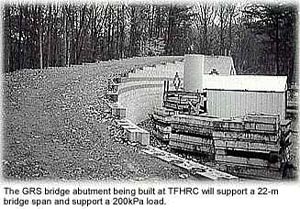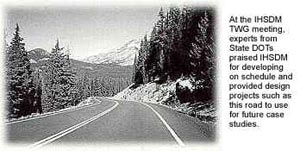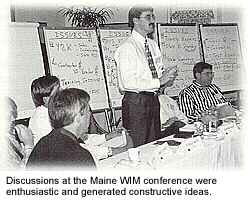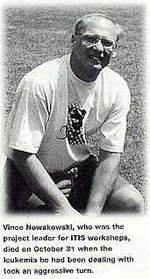U.S. Department of Transportation
Federal Highway Administration
1200 New Jersey Avenue, SE
Washington, DC 20590
202-366-4000
Federal Highway Administration Research and Technology
Coordinating, Developing, and Delivering Highway Transportation Innovations
|
Research & Technology Transporter This newsletter is an archived publication and may contain dated technical, contact, and link information. |
|
| Publication Number: N/A Date: December 1998 |
Publication Date: December 1998
|
FHWA engineers are constructing two full-scale, Geosynthetic Reinforced Soil (GRS) bridge abutments at TFHRC. Previous research conducted by the Colorado DOT and TFHRC indicated that using a GRS design is a more versatile, practical, and cost-effective method to construct simple bridges. Engineers are building the new bridge at TFHRC to refine the design of GRS embankments used with concrete modular blocks and to examine how the reinforcement width and strength are affected by the spacing of geosynthetic reinforcement.

The abutments, designed to support a 22-m bridge span, consist of alternating layers of compacted gravel and geosynthetic reinforcement confined within a wall of dry-stacked modular block. Unlike conventional bridge designs, which require a deep foundation system to support the footings, this technology allows the superstructure to rest directly on the surface of the GRS mass.
Currently, one abutment is complete and the other is under construction. The bridge girders will be set in place as early as next spring. These abutments are designed to accommodate a variety of girders, the first set of which will come from a decommissioned bridge in New York. Once the girders are in place, researchers can then load the superstructure with grouted anchors, which will be installed in the ground between the abutments. The embankment walls and abutments will be monitored for performance during loading. The abutments are designed conservatively to support a load of 200kPa and are expected to show a minimal deflection of less than 12 mm.
Mike Adams (202) 493-3025 mike.adams@fhwa.dot.gov
On October 16, FHWA and Surfan Engineering and Software, Inc. brought their jointly developed Road Surface Analyzer (ROSAN) to the John F. Kennedy (JFK) International Airport to assess the runway conditions.

ROSAN, which was developed to measure road surface texture at highway speeds, determined the groove depth on all four runways at JFK airport. These grooves are cut into the runway surface to channel water away from the tires and prevent aircraft from hydroplaning. However, as heavy jets land on a runway, rubber from their smoking tires fills these grooves. The build up of rubber prevents the water from running off. This standing water on the runway could cause the aircraft to hydroplane when the pilot applies the brakes.
By using ROSAN, maintenance crews can ensure the groove depth and texture of the paved surface are adequate to avoid hydroplaning. By monitoring the existing conditions of the runway and forecasting the depth of the grooves through the use of ROSAN, these crews can determine the optimum time to clean or resurface runways, thereby increasing the safety of the runway.
Dennis Sixbey (202) 493-3078 dennis.sixbey@fhwa.dot.gov
An updated version of the Long-Term Pavement Performance (LTPP) program's software package, DataPave, has been released. The new package, DataPave 1.1, now provides users with updated tables for transverse profile measurements, manual distress information, and monitored traffic equivalent single-axle load values.
Introduced at the January 1998 Transportation Research Board meeting, DataPave is LTPP's revolutionary software package that presents LTPP data on an easy-to-use CD-ROM. These data include inventory, material testing, pavement performance monitoring, climatic, traffic, maintenance, rehabilitation, and seasonal testing information from approximately 2400 pavement test sections at 900 locations on in-service highways throughout North America.
In addition to the LTPP data, DataPave also provides users with a set of tools for searching, viewing, and manipulating the data. All of the data on the CD-ROM have gone through LTPP's quality control procedures, and the package has been extensively tested to ensure that it will work on all computers using the Microsoft Windows™ 95 or Windows™ NT operating systems.
Simple and easy-to-use, DataPave unlocks the potential of LTPP data for the development of products to improve pavement technology.
Kurt Dunn (816) 276-2734 kurt.dunn@fhwa.dot.gov.
FHWA has now developed Traffic Noise Management (TNM ) Look-Up Tables to aid highway traffic noise analysts. The Look-Up Tables are designed as a screening tool to be used with the Traffic Noise Model (FHWA TNM), the current model prediction software, in simple applications. FHWA TNM calculates traffic noise levels using acoustical algorithms.
The TNM Look-Up Tables are pre-calculated FHWA TNM results for simple highway geometries. The calculations are for an infinitely-long, straight roadway over flat ground with a receiver set at a height of 1.5 m above the ground. If desired, an infinitely-long straight barrier may also be included in the calculations.
The TNM Look-Up Tables are accompanied by TNMLOOK, a complementary DOS program. TNMLOOK is PC-compatible and is written in Microsoft Fortran Version 5.0. Highway traffic noise analysts have a choice of using either the TNM Look-Up Tables or TNMLOOK to determine the sound levels associated with a particular geometry. The tables should be useful to all individuals involved with the analysis of highway traffic noise.
The TNM Look-Up Tables were developed with assistance from the Volpe National Transportation Systems Center (VNTSC). A copy of the tables and a diskette containing TNMLOOK can be obtained from VNTSC.
Steve Ronning (202) 366-2073 steven.ronning@fhwa.dot.gov
The Pedestrian Safety Road Show (PSRS), a DOT program designed to help local communities identify and solve issues concerning pedestrians, was featured at two recent national conferences. PSRS generated strong interest from engineers, safety specialists, planners, law enforcement officials, pedestrian/bicycle groups, and educators.

ProBike/ProWalk '98 conference, which was sponsored by the Bicycle Federation of America and held in Santa Barbara, CA, participants emphasized that local communities are in the best position to solve their own pedestrian problems, provided that they have the right tools. PSRS's modular process can be tailored to fit the individual needs of the community. These individual modules can also be used as stand-alone exercises to make decisionmakers and local communities more aware of pedestrian issues. The workshop brings together many quality-of-life issues - such as health, the environment, and recreation that concern both the public and private sectors.
This growing interest in pedestrian safety was also demonstrated at the American Public Works Association (APWA) conference in Las Vegas, NV. The workshop was the first of its kind at an APWA conference and more than 150 people attended the PSRS workshop. Participants discussed, among other issues, the Transportation Equity Act for the 21st Century (TEA-21) and its implications for funding pedestrian programs, such as:
Those attending the workshops agreed that walking and biking are modes of travel and should be integrated into the planning, design, and operation of all roadways. TEA-21 allows communities to invest in projects that can make those modes of travel safer and more practical than before.
Leverson Boodlal (202) 366-7909 leverson.boodlal@fhwa.dot.gov
Researchers continue to forge ahead in the development of the Interactive Highway Safety Design Model (IHSDM). At the IHSDM Technical Working Group (TWG) meeting held in September at TFHRC, State DOT officials showed winning support for the project.

At the IHSDM TWG meeting, hosted by FHWA's Office of Technology Applications and the FHWA Safety Design Division, TWG members representing various State DOTs throughout the country praised researchers for their work on IHSDM.
IHSDM TWG members also offered their own expert contributions to IHSDM and its five modules: accident analysis, design consistency, driver/vehicle analysis, policy review, and traffic analysis. State DOT members provided critical evaluations and recommendations concerning IHSDM's future. The TWG members assessed the current and proposed IHSDM functionality to ensure that IHSDM will provide maximum benefits to the end users, roadway planners and designers.
IHSDM TWG members also provided valuable insight concerning the likely scenarios for State DOT applications of IHSDM in making roadway design policy decisions. They explained how IHSDM can best be incorporated into State DOT work flow and at which stages of project development IHSDM can have the most impact.
For a copy of an IHSDM Preview CD-ROM or for further information concerning IHSDM, call the contact below.
Ray Krammes (202) 493-3312 ray.krammes@fhwa.dot.gov
The Second European Conference on Weigh-in-Motion (WIM) of Road Vehicles was held in Lisbon, Portugal, in September. The conference was sponsored by "COST323," a European Commission working group representing road research agencies that focus on WIM research, standardization, and testing. Hosted by the Portuguese road authority, Junta Autônoma de Estradas, and attended by more than 160 people from all over Europe and the world, the conference included approximately 50 technical presentations and "pre-proceedings," and an exhibition of 10 vendors.
Ralph Gillmann of the Travel Monitoring Division, Office of Highway Information Management (OHIM), participated in a panel discussion led by Secretary General of the World Road Association Jean-François Coste. Gillmann also participated in a post-conference meeting regarding the continuation and expansion of international cooperation in WIM research and standards and whether the World Road Association (PIARC) will become the sponsoring organization for this initiative.
Ralph Gillmann (202) 366-5042 ralph.gillmann@fhwa.dot.gov

A recent weigh-in-motion technical exchange conference, sponsored by the Maine Department of Transportation and FHWA's Eastern Resource Center, generated various discussions between public purchasers and private vendors. The more than 50 WIM professionals, representing 11 northeastern States, 3 Canadian Provinces, the LTPP North Atlantic Region, 12 equipment vendors, and FHWA that attended the conference strived for a consensus on solutions that would be beneficial to all participants.
State participants discussed WIM equipment issues, presented these prioritized issues to the vendors, engaged in interactive discussion, and presented current "tricks of the trade" relating to equipment installation. The formal meetings were followed by demonstrations of current equipment hardware and software, independent discussions with vendors, and informal interaction between participants.
Quality WIM data are now being collected by organizations that participated in the conference. The resulting data will be used to improve many highway functions.
Fred Orloski (513) 431-4224 fred.orloski@fhwa.dot.gov
Total social costs of motor vehicle use range from $1.7 trillion to $3.3 trillion annually. The public-sector share of these costs for infrastructure and services falls between $131 billion to $247 billion. Both the Intermodal Surface Transportation Efficiency Act (ISTEA) and the Transportation Equity Act for the 21st Century (TEA-21) encourage full consideration of these costs and their social, economic, and environmental impacts on transportation decisions.
To assist planners in understanding the full social costs of motor vehicle use, FHWA sponsored research by Dr. Mark Delucchi of the University of California at Davis. His research classified social costs into six groups: (1) explicitly priced private-sector costs, such as vehicle operating costs; (2) personal non-monetary costs, such as travel time; (3) bundled private-sector costs, such as parking provided free to commuters; (4) public-sector costs, such as road construction and maintenance; (5) monetary externalities, such as lost wages due to incapacitation caused by accidents; and (6) non-monetary externalities such as air pollution.
In continuing work, Dr. Delucchi will be developing marginal social cost functions and estimates for use in transportation planning and in evaluation tools such as FHWA's Surface Transportation Efficiency Analysis Model (STEAM), the ITS Deployment Analysis System (IDAS), the SCALDS model (see Transporter, October 1998), and the Federal Highway Cost Allocation Study.
Dr. Delucchi's research has been published in FHWA's Metropolitan Planning Technical Report No.10 The National Social Cost of Motor Vehicle Use, (FHWA-PD-99-001), available on the web at www.ota.fhwa.dot.gov/scalds or via fax at (301) 386-5394.
Patrick DeCorla-Souza (202) 366-4076 patrick.decorla-souza@fhwa.dot.gov.
More than 80 landscape architects, designers, maintenance personnel, and project development specialists from Mid-Atlantic State highway agencies (SHAs) came together in Baltimore, MD, to share ideas on the use of native vegetation in roadside landscaping. "New Approaches for Utilizing Native Plants on Roadsides," a two-day workshop sponsored by the FHWA Eastern Resource Center and the Maryland State Highway Administration, featured presentations by subject matter experts and included a bus tour of Maryland roadside vegetation projects, a visit to the United States Department of Agriculture National Plant Materials Center, and break-out sessions to discuss practical strategies for using native vegetation in highway projects.

The workshop participants represented a number of modes of transportation, highways, parkways, transit, toll authorities, airports, and a wide range of Federal, State, and local agencies such as FHWA, SHAs, the U.S. Park Service, the U.S. Department of Agriculture, the U.S. Fish and Wildlife Service, local public works departments, regional vendors of native vegetation, landscaping consultants, and university researchers and students.
Speakers discussed topics including national trends, FHWA policy, Maryland's SHA effort to create a natural roadside, the Chesapeake Bay's BayScape Program (landscaping using non-invasive native vegetation indigenous to the Chesapeake Watershed), reforestation on the Baltimore-Washington Parkway by the National Park Service, and the availability of native grasses and wild flowers that work well for roadside revegetation. The keynote speaker and resource person throughout the conference was Bonnie Harper-Lore, FHWA's Native Vegetation specialist and editor of Greener Roadsides.
Workshop participants expressed a strong interest in working with FHWA's Eastern Resource Center to host a similar event on an annual basis. Participants and organizers agreed that the workshop provided valuable new technical information on vegetation, as well as an opportunity to learn what neighboring States are doing, and about the "latest and greatest" in the seed and nursery stock business.
Jerry Barkdoll (410) 962-0077 ex. 3075 jerry.barkdoll@fhwa.dot.gov
To understand how to best deal with managing today's vast amount of transportation information, FHWA presented the Integrated Transportation Information Systems (ITIS) workshop in Philadelphia, PA. This was the first time the workshop was presented in a major metropolitan area.
The purpose of the FHWA-sponsored workshop was to introduce transportation professionals from State and local transportation agencies to the basic concepts of developing, implementing, and maintaining an ITIS.

An ITIS is the fusion of all transportation information systems into a single and comprehensive information system architecture that best supports the transportation agency business purposes. The workshop presented applications of an ITIS and its associated enabling technologies.
The workshop will be offered several times this year, including a pre-TRB conference workshop scheduled for Sunday, January 10 in Washington, D.C.; a Connecticut DOT workshop schedule for January 13 and 14; and the GIS-T Symposium in San Diego, CA, scheduled for March 1999.
Doug Lockett 202-366-1257 doug.lockett@fhwa.dot.gov
Vincent Nowakowski, project leader for the ITIS workshops, our friend and colleague, died on October 31 at Georgetown Hospital. The leukemia, which he had been fighting for so long, took an aggressive and sudden turn. It is a loss to all who knew and were touched by him.